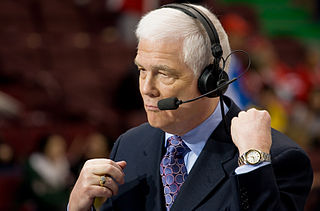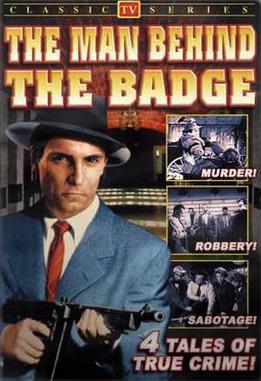
Oswald George Nelson was an American actor, filmmaker, musician and bandleader. He originated and starred in The Adventures of Ozzie and Harriet, a radio and television series with his wife Harriet and two sons David and Ricky Nelson.

The Adventures of Ozzie and Harriet is an American television sitcom that aired on ABC from October 3, 1952, to April 23, 1966, and starred the real-life Nelson family. After a long run on radio, the show was brought to television, where it continued its success, initially running simultaneously on radio and TV. In terms of seasons, it was the longest running live-action sitcom in U.S. television history until It's Always Sunny in Philadelphia surpassed it on December 1, 2021. The series starred the entertainment duo of Ozzie Nelson and his wife, singer Harriet Nelson, and their sons, David and Ricky. Don DeFore had a recurring role as the Nelsons' neighbor "Thorny".
The Man Called X is an espionage radio drama that aired on CBS and NBC from July 10, 1944, to May 20, 1952. The radio series was later adapted for television and was broadcast for one season, 1956–1957.

Shecky Greene is an American comedian. He is known for his nightclub performances in Las Vegas, Nevada, where he became a headliner in the 1950s and '60s. He has appeared in several films, including Tony Rome; History of the World, Part I; and Splash. In television, he has guest-starred on such television shows as Love, American Style and Combat!, and later Laverne & Shirley and Mad About You.

Dave Hodge is a Canadian sports announcer. Hodge worked for TSN, the CBC and CFRB 1010 radio in Toronto.

Benjamin Franklin Grauer was a US radio and TV personality, following a career during the 1920s as a child actor in films and on Broadway. He began his career as a child in David Warfield's production of The Return of Peter Grimm. Among his early credits were roles in films directed by D.W. Griffith.

Elliott Lewis was an American actor, writer, producer, and director who worked in radio and television during the 20th century. He was known for his ability to work in these capacities across all genres during the golden age of radio, which earned him the nickname "Mr. Radio". Later in life, he wrote a series of detective novels.

Kliph Nesteroff is a best-selling author regarded for his vast knowledge of show business. Vice Magazine called him "The Human Encyclopedia of Comedy," and Los Angeles Magazine profiled him as "The King of Comedy Lore." The New York Times has deemed some of his theories "provocative" while Vanity Fair calls his work "essential." Nesteroff was included on LA Weekly's Best of Los Angeles list in 2016, and was dubbed the "premier popular historian of comedy" by the New York Times in 2021.

The Man Behind the Badge is a half-hour American television police drama series which aired on CBS from October 11, 1953, to October 3, 1954, originally hosted by Norman Rose. In its second syndicated season, the host became character actor Charles Bickford. Jerry Robinson was the producer.
The Magic Key of RCA was an American variety radio show that featured an unusually large and broad range of entertainment stars and other noted personalities. It was on the NBC Blue Network from September 29, 1935, until September 18, 1939.

Dick Joy was an American radio and television announcer. A journalism major at the University of Southern California, he went on to become well known on network radio and television.
The Raleigh Cigarette Program was an American old-time radio comedy program that starred comedian Red Skelton.

Joyce Jordan, M.D. is a radio soap opera in the United States. It was broadcast on ABC, CBS and NBC at various times during the era of old-time radio.
The Bob Crosby Show can refer to any of several old-time radio musical variety program in the United States. They were broadcast on CBS, Mutual and NBC, with the first beginning in 1935 and the last ending in 1950.
Brave Tomorrow is an old-time radio soap opera in the United States. It was broadcast on NBC October 11, 1943 – June 30, 1944.

Brenda Curtis is an old-time radio soap opera in the United States. It was broadcast on CBS September 11, 1939 - January 19, 1940.

Bride and Groom is an old-time radio human-interest program in the United States. It was broadcast on ABC from November 26, 1945 to September 15, 1950. Each episode featured an engaged couple who would be married during the broadcast, then showered with gifts.
The Danny Kaye Show is an American old-time radio comedy-variety program. Broadcast on the CBS radio network, it ran from January 6, 1945 to May 31, 1946.
Doc Barclay's Daughters is an American old-time radio soap opera. It was broadcast on CBS from January 23, 1939, to January 19, 1940.
John Donald Wilson was a radio and film writer, producer, and voice actor, born in Kansas City, Missouri.












